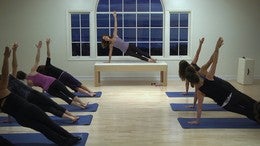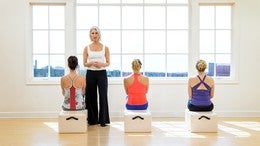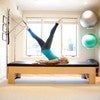Description
About This Video
Transcript
Read Full Transcript
Hi, I'm Madeline black and I'm going to do a tutorial for you on specifically the v t bro Maneuver, BREEAM region of the thorax. Um, this area is very interesting because it's two rings, a rib one and rib two relating to the maneuver IOM, which is the top part of the sternum. The clavicles sit over the first rib and it articulates with t one and two. So this whole region has a movement capacity for moving the neck and which therefore moves your head, uh, and also the elevation of your arms. So when there's a restriction, uh, in the soft tissue in the area, specifically when we have a restriction of the subclavius muscle, which is right underneath the clavicle and the, uh, upper trapezius muscle here through this area here and the southern sip ital muscles, which sit at the base of little six muscles right at the base through here and also the Rom Boyd Minor, uh, when there's a restriction there.
So I target those muscles because it's so interesting, uh, to notice that when there's a holding in these areas, like under the clavicle and at the base of the head. And the scapular through the rhomboid minor and the upper trapezius. This restriction will play to an asymmetry and an imbalance for the first and second ribs, and it actually affects the rotation of the neck and the arms. So if you can find a way to release and move these muscles, it will actually help in terms of all the Scapula humeral rhythm, uh, motion of the arms and also the rotation of the neck. Um, we tend to, um, have a preferred way of rotating in this area.
So this is a very small rotation that is lacking in many people's motion. And this rotation is, I use an image of the clavicles is like a seesaw for kids. You know, that one sits on one end and it goes up, one sits on one end going that way, or you can also rotate the clavicles back and forth this way. So there's an awareness of rotation here versus doing it in your waist here. So we tend to over twist here, uh, and we tend to lack a little bit of motion here at this joint. So it's the IOM that is facing like mine's facing the right and facing the left.
So this rotation happens when we're swinging our arms and also in the neck. If this suboccipital muscles in the neck are restricted, then we're not able when we're not able to get the rotation of the neck because it's being held at this area. So when this is moving side to side, there's a a sending rotation of each of the cervical vertebraes. So if you start to s to rotate here, there's actually a very subtle little rotation that's happening through the neck and your head is actually staying stable cause you're looking where you're going. So this is a pretty vital, uh, area for balance, you know, meaning your head balance, uh, our movement and to have your neck, uh, free. So, um, what happens with some people's, um, restriction is that um, t one and two, uh, that 71 and two are related to the [inaudible]. So if we have, and we all do have a little bit of a preferred way of rotating.
So that means that these two vertebrates can be rotating, which would then show up as a rotation of the maneuver IOM. So if my spinus processes of t one and two are facing the right, right? So those bones are going that way, it's gonna make my maneuver IOM rotate to the left. So hopefully you can see that. So as this rotates to the right, the maneuver IOM is gonna rotate left. So sometimes we get kind of held up and that's a lot of it. This Ron Boyd minor in this area, we'll actually pull those vertebraes in that rotation and then it will affect the clavicle alignment.
So if my maneuver BREEAM is a little prefers to be stuck in this rotation to the left, then you're going to notice that the uh, rotation of the clavicles are going to change and there's going to be an elevation of one. So as I rotate left, as you can see, this becomes more prominent. This comes forward. So if I'm living in this kind of rotation, this is going to immediately affect the chromium joint here, which is going affect also the elevation of my arms. And my shoulders. So, and it's also going to affect how my neck is going to rotate. So this is a really important area. If we can kind of get some movement in there, we can unlock a lot of this, uh, restriction we might have when we are trying to lift our arms up or turn our neck. So we're going to take a look now at a person moving their neck and the arm so you'll be able to see this dynamic, uh, motion and action.
So now we're going to watch Aaron do the motion of this first region here. So Aaron, you haven't crossed your arms and let them be relaxed and I'm gonna hold her head stable so that the rotation truly occurs in the first and second ribs. And you should see how that translates up into her neck without her head moving. So she's going to rotate to the right, very nice. And then come back to center and then to the left.
And I can feel there's a little bit of a restriction. A, I can just feel the tension up into her neck care and she's tending to, as you can see, your scapula starts to retract and she's rotating down a little bit more. So rotate to the right so it's nice and easy and come back. No tension in her neck. And she's going to rotate to the left and she starts to dip down just a little bit here. Okay. And come back. So what's happening is her ring is a, she has beautiful movement in either direction, it's just that she prefers to rotate to the right up here and then the left is just has a little bit more restriction. Uh, so it could be that, um, she is restricted going this way because her spine is processes that I discussed are facing a little bit to the left. Okay. This way, which would make her maneuver IOM move to the right. So if she's being held here, it's going to be a little bit more difficult for her to move in that direction.
All right. Which would also affect her scapulohumeral rhythm. So we're going to take a look at that. So first just have your arms down by your side and uh, she's going to slowly lift both arms up from the side and we should see the humerus moving the pause, right? So humorous moves scapularis stays pretty much where it is now. As she elevates up higher, you see the scapular doing it's upward rotation.
Very beautiful. And then if you were looking in the front, you would see the clavicle starting to rotate upward in this direction this way as she goes up, right? And then she comes back down and write and pause. So right here, this is the hard part in watching this with some people is that now's the point where the arm should come down without the scapula. Really moving too much more so than start bringing the arms down. Now pause. So there now should no longer move and just bring your arms down. Very nice. Good. So because of this bit of a restriction in this area though, will we will be a slight difference in the way that her, if you look at the timing between the right and the left side, there's a little bit of a difference in her. So do it one more time.
Pause. So that right scapula started to rotate upward before the left one did. So I don't know if you notice that. So and then continue up and then that left one goes good. And you'll also notice some of this, um, the difference between the length of the tension here and here. And this is probably coming from the clavicle, that clavicle restriction on not allowing that humeral head to actually sit in the socket the way it should.
The way I'd like to see it. All right. So the shortening here is not a bad thing. Okay? It's actually what I'm concerned about is how lax this is here in terms of her strength of this shoulder. Okay. And bring your arms down. All right. So let's have you, um, I'm going to walk over to this side and you're going to grab ahold of this pole and we're going to lengthen your arm out. So when I'm working with a pole in retraining the scapular whom were rhythm, um, I pay attention to where the humeral head is in relationship to the Scapula and the front of the body and the clavicles. So there is an angle.
It's a technical term called scaption, which just means the angle of the Scapula. Okay? And so we're going to start low here and you can also see how the shoulder blade sits a little bit different on the rib cage. So we want to see that the rib cage is kind of resting into the scapula. So I'm going to ask her to pull down just very slightly on the pole, so that helps engage the musculature there. And then we're going to go up and she's giving me a little resistance, but not much. I'm winning. So then we can see. Yeah. So we're going to, now you see the scapular moving. This is great, Erin. Good. And I keep that.
I'm going to keep it working and then we'd go higher. Do a little d. That's it. That's that. She's still working the muscles as we come up. And they'll feel that you can rotate the clavicle upwards. Just imagine that rotation up. There you go. Great. And now bring the stick down.
Don't pull hard cause we don't want to depress the humeral head. So you're a very mobile person. So the head of that humerus really likes to kind of drop down. And that's why we're seeing this overlength in here. So we'll do it one more time.
So don't pull hard cause that's going to depress your humeral head. So it's more just feel the weight of the stick. There you go. Now as we start to go up, start thinking, imagining that clavicle rotating upward to keep the rotation of the clavicle. A little more rotation. There you go. That's it. That's it. That's it. That's it. That's it. That's it. Good. And then don't pull hard, but just bring the stick down. Keep that clavicle there.
Try to keep that lift rotation. Good. And then let go. Okay, let your arms go down. And let's see if that changed. Uh, just by activating that. So let's go up again. Rotating, right? Very good. Now think of the clavicle rotation at that set. Very good.
All the way up. Excellent. And stay there. This is good. So now I've got the upper trap in a nice, it's engaged before it was kind of slacked out and now this distance has kind of toned up and that's going to give you support. So I know we focus on not having a tense NACA. We tried to get people to let go the upper traps, but for mobile people, especially the upper trapezius actually needs to engage. When it's too long, it creates a lot more tension in the neck. So, and all right, come back in this, hold your elbows now and we're just going to hold your elbows like we did in the beginning. All right. And I want to just see how her rotation is a, so I want you to rotate to the right again. So that was her preferred way.
It was very nice. Still Nice and come back and then we're going to go to the other side, much better, excellent and come back down good. And we were able to achieve a little better movement in that way because of, I believe that motion of the clavicle rotating up, which meant hers Subclavius had to not adhere the bone down. And then we also got the rum Boyd minor to lengthen out through their booth activity through the shoulder. And it's a little bit of like neuromuscular reprogramming there too.
So that would be, uh, did an example when we're doing our PyLadies workouts where when we're bringing our arms out to the side or forward in front, that we have that activity going, not just scapula humeral rhythm, but that having awareness around the manubrium. So new cues for you would be to rotate the clavicles back this way and also asking people when they rotate to, I give one image where you have like a light beam off of your maneuver eum and that you're going to shine the light to one side or shine the light to that side. We want to try to encourage the small rotation that needs to happen in this area. So in your movements, just put your attention there and you should be able to improve the strength of your shoulder girdle and relieve any kind of neck tension you might have.
Comments
You need to be a subscriber to post a comment.
Please Log In or Create an Account to start your free trial.




















